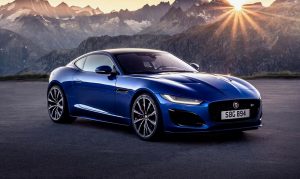The DB Mark III (normally simply called Mark III, even at the time of its introduction) is a sports car sold by Aston Martin from 1957 through 1959.
It was an evolution of the DB2/4 Mark II model it replaced, using an evolution of that car’s W.O. Bentley-designed Lagonda 2.9 L (2922 cc/178 in³) straight-6 engine, redesigned by Tadek Marek. Ian Fleming’s James Bond drives an Aston Martin DB Mark III in the seventh James Bond novel Goldfinger (1959).
“The car was from the pool. Bond had been offered the Aston Martin or a Jaguar 3.4. He had taken the DB III. Either of the cars would have suited his cover – well-to-do, rather adventurous young man with a taste for the good, fast things of life. But the DB III had the advantage of an up-to-date triptyque, an inconspicuous colour – battleship grey – and certain extras which might or might not come in handy. These included switches to alter the type and colour of Bond’s front and rear lights if he was following or being followed at night, reinforced steel bumpers, fore and aft, in case he needed to ram, a long-barreled Colt .45 in a trick compartment under the driver’s seat, a radio pick-up tuned to receive an apparatus called the Homer, and plenty of concealed space that would fox most Customs men.”

James Bond drives an Aston Martin DB Mark III in the novel version of Goldfinger, though it is referred to as a “DB III” in the book – indeed, the chapter in which he drives to his famous golf-course encounter with the villain is entitled ‘Thoughts in a DB III’. The “DB3” was a car designed specifically for racing and is unlikely that Bond would drive one. The DB Mark III is often called the DB III and is more comparable to its description in Fleming’s novel.

It is the only Bond car in the Ian Fleming novels to have gadgets installed. It included switches to alter the type of color of the front and rear lights, reinforced steel bumpers, a Colt .45 pistol in a trick compartment under the driver’s seat, and a homing device similar to the DB5 in the film. For the film adaptation five years later, the car was updated to the Aston Martin DB5 model and the array of gadgetry was much expanded. It was to become one of the most iconic of classic cars as a result.
Design and performance
Changes included a grille like that on the DB3S, a new instrument panel, and available Girling disc brakes. The hydraulically operated clutch was new as well, and an optional Laycock-de Normanville overdrive that was attached to the STD 4 speed gearbox after the 1st 100 cars or even an automatic transmission were available. Worm-and-sector steering and a live axle rear end were carry overs. At the rear, the DB2/4 Mark II’s tailfins (after the 1st few early cars) were altered to use the rear lights from the Humber Hawk.

The standard DBA engine model with twin SU carburettors produced 162 hp (121 kW), though an optional dual-exhaust system (a claimed 16 b.h.p. increase) raised this to a reputed 178 hp (133 kW). Thus equipped, the car could reach 60 mph (97 km/h) in 9.3 seconds and hit 120 mph (193 km/h). An optional high-output DBB engine with three twin-choke Weber 35 DCO 3 carburettors, special long duration camshafts, high compression 8.6:1 pistons and the dual-exhaust system boasted 195 hp (145 kW), though this was rarer ( 10 cars thus equipped) than the mid-level DBD option with triple SU 1.75″ carbs and 180 hp (134 kW) also with the dual exhaust system, fitted to 47 cars. Girling disc brakes were fitted as standard to the front wheels of all Mk III Astons after the first 100 had been made. Many cars were upgraded later.

The DB Mark III is arguably the first ‘James Bond’ Aston Martin, appearing in Ian Fleming’s novel Goldfinger.
Barn find and project cars sold well, with a brace of 1958 Aston Martin DB Mark III Sports Saloons selling particularly well, one selling at twice top estimate, achieving £104,540, and the other at £115,740.
A 1959 review by Road & Track magazine praised the car for everything but its $7,450 price. “A car for connoisseurs,” they called it. “The Aston has many virtues and few faults.” Among the faults was too-heavy steering effort, high door sills, and a stiff ride. Interestingly, R&T failed to comment at all on the car’s innovative hatchback body style, complete with fold-down rear seats, although this had been first introduced in the 2/4 MkI in 1953.
Vehicle information
Model
Manufacturer
Production
Engine
Torque
Transmission
Power
Top Speed
0-60 mph
Dimensions
W 1,651 mm (65 in),
H 1,359 mm (53.5 in)
Weight
Share this:
- Click to share on Facebook (Opens in new window)
- Click to share on Twitter (Opens in new window)
- Click to print (Opens in new window)
- Click to share on LinkedIn (Opens in new window)
- Click to share on Reddit (Opens in new window)
- Click to share on Tumblr (Opens in new window)
- Click to share on Pinterest (Opens in new window)
- Click to share on Pocket (Opens in new window)
- Click to share on Telegram (Opens in new window)
- Click to share on WhatsApp (Opens in new window)




